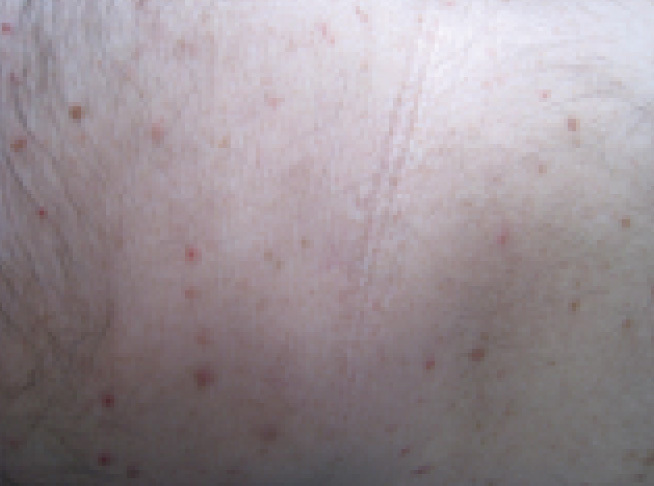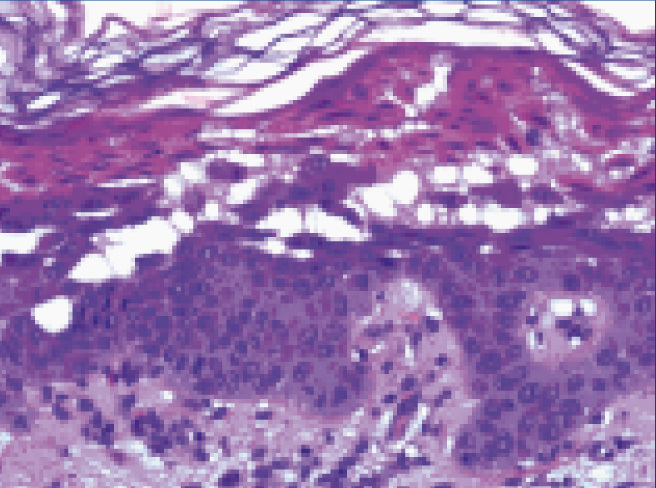To the Editor:
Grover's disease is a dermatosis, which is characterised by erythematous, pruritic maculopapular exanthema, mainly on the trunk. Chronic kidney disease under dialysis is a predisposing condition due to mechanisms that have not been fully explained. We report the case of a 68-year-old male with polycystic kidney disease who had been on continuous ambulatory peritoneal dialysis for six months, with benign prostatic hyperplasia that caused multiple recurrent urinary tract infections. He received prophylactic treatment with trimethoprim/sulphamethoxazole (TMP-SMX). He sought consultation due to 38°C fever, general discomfort, asthenia and, 48 hours previously, he had developed erythematous pruritic maculopapular lesions on his trunk and subsequently on his limbs. On physical examination, the patient was afebrile, with erythematous maculopapular rash on his trunk and limbs (Figure 1). There were no relevant findings in the remaining physical examination. Complementary examinations showed bicytopenia with no other findings. A skin biopsy was performed (Figure 2), revealing suprabasal acantholysis with the presence of dyskeratotic cells in the superficial layers in the form of grains and round bodies and mild dermal perivascular inflammatory infiltrate in the superficial dermis; these findings are consistent with Grover's disease. Icodextrin was replaced with dextrose-based solutions, sulphonamide was discontinued and there was remission of skin lesions and bicytopenia. With TMP-SMX initially being considered as a potential ethological agent, the dialysis solution with icodextrin was reintroduced and the skin exanthema returned in a week. Improvement was observed with the introduction of topical corticosteroids and the discontinuation of icodextrin.
Transient and persistent acantholytic dermatosis (TAD) was initially described by Ralph Grover as a transient papulovesicular rash that compromised the trunk and thighs.1 It is usually self-limiting2 and primarily affects Caucasian adults from the fifth decade of life with a 1.6 to 2.1 male/female ratio.3 Its aetiology is unknown and has been associated with overexposure to the sun, feeling hot, fever, sweating, states of immunodeficiency, neoplasias and other dermatoses.1 Some cases have been associated with drugs, among them, sulphadoxine/pyrimethamine.4 Chronic kidney disease receiving treatment with dialysis is a recently identified associated condition. Until present, TAD has been reported in seven haemodialysis patients and only in two patients on peritoneal dialysis.2 In these cases, the lesions were persistent, apart from in four patients, in whom renal transplantation was performed. In most cases Grover's disease mainly affects the trunk. The rash is papular, erythematous and intensely pruritic. Histopathologically, the common denominator is acantholysis, defined as the dissociation of keratinocytes from the epidermis.4 The differential diagnosis is made with genodermatosis, pemphigus and Galli-Galli disease. Topical corticosteroids, antihistamines, moisturisers and emollients are the first line therapeutic agents. In persistent or recurrent cases, the following is recommended: systemic corticosteroids, topical vitamin D analogues, systemic retinoids, phototherapy and PUVA (psoralen plus ultraviolet A photochemotherapy).
This case was initially targeted as TAD secondary to sulpha drugs. However, our attention is drawn to the exacerbation and subsequent remission of symptoms with the reintroduction and then discontinuation of icodextrin-based dialysis solutions. The use of icodextrin in peritoneal dialysate has been associated with the onset of erythroderma, atopic dermatitis and other generalised rash exanthemas.5 TAD should be considered in the differential diagnosis of skin diseases in chronic kidney disease patients who receive renal replacement therapy.
Conflicts of interest
The authors declare that they have no conflicts of interest related to the contents of this article.
Figure 1. Erythematous maculopapular rash on the trunk
Figure 2. Skin biopsy consistent with Glovers disease










